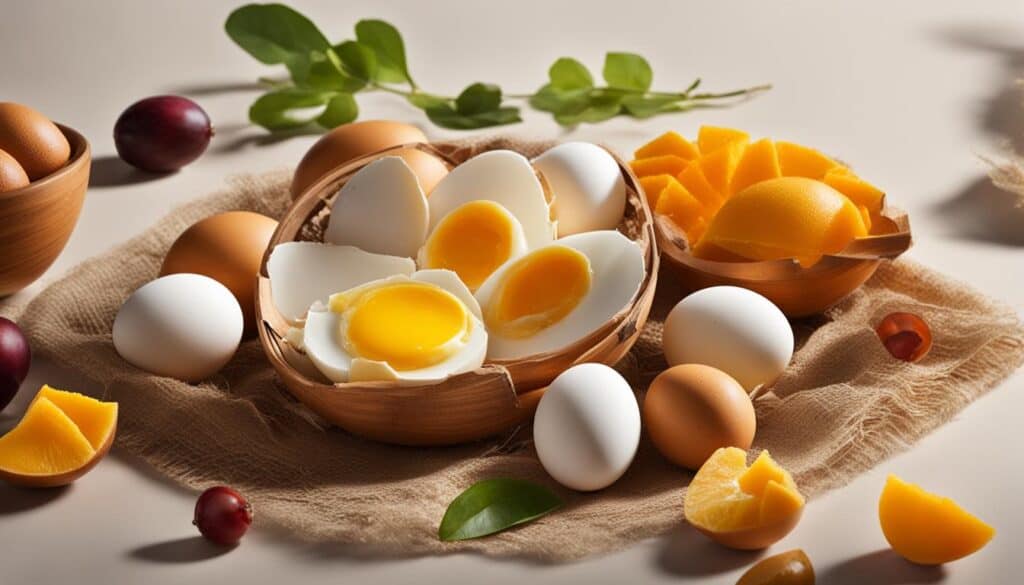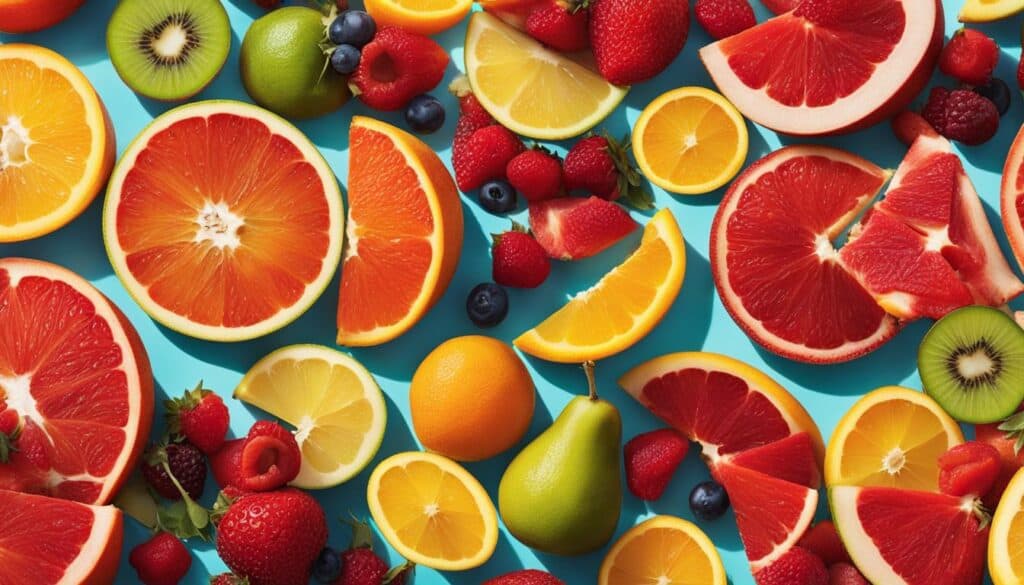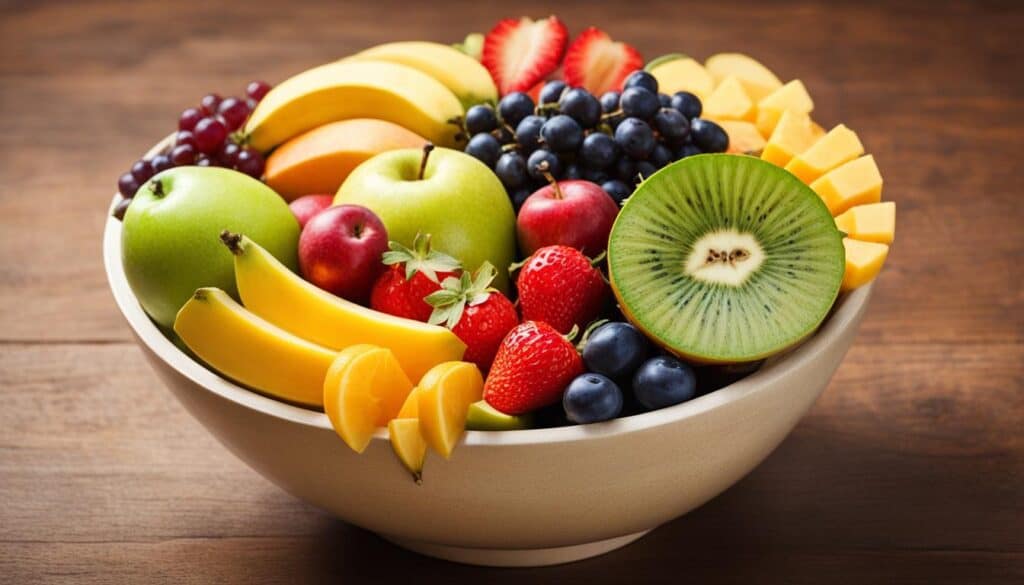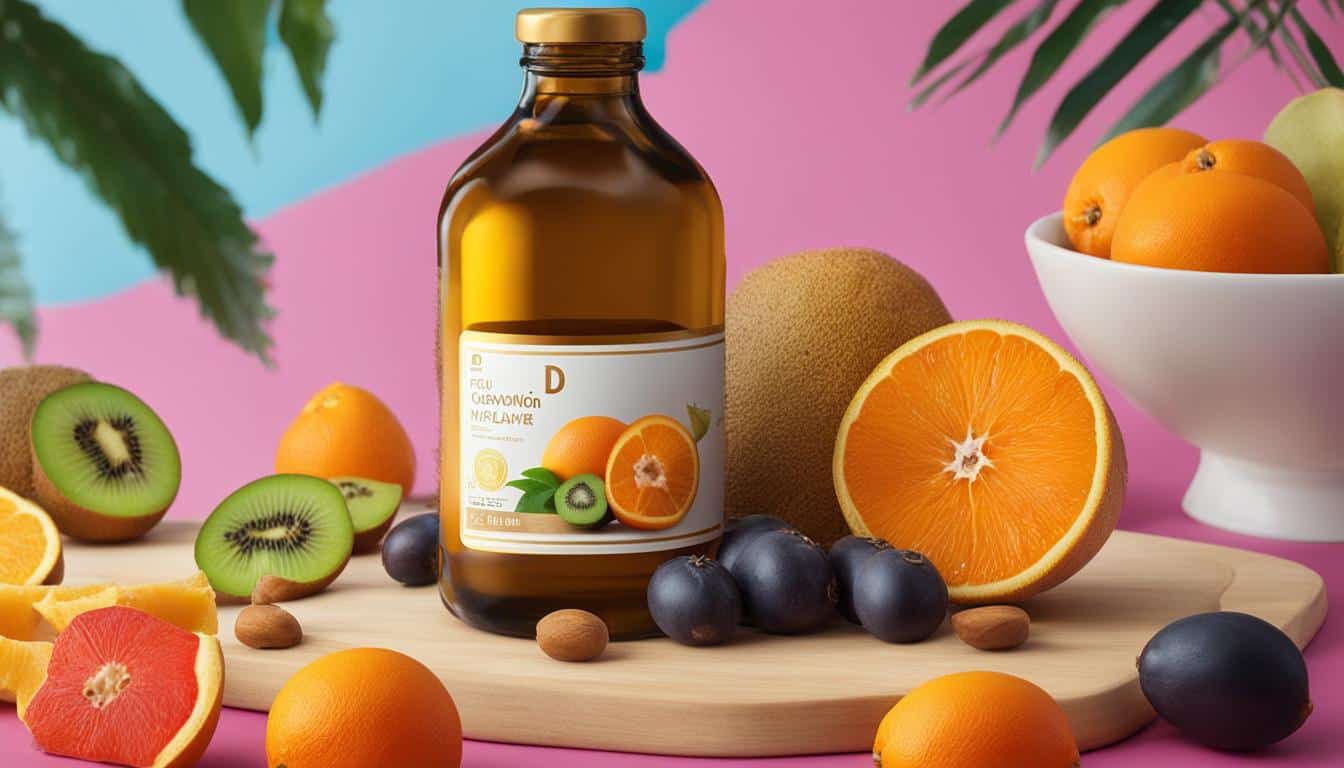Hello, I’m here to shed some light on the topic of vitamin D and fruits. Many people wonder whether fruits contain vitamin D and how they can incorporate this essential nutrient into their diet. Let’s explore the world of fruits and vitamin D together!
Before we dive into the specifics, it’s important to note that fruits do not naturally contain vitamin D. However, there are other food sources that are rich in this essential nutrient. Vitamin D is crucial for bone health and plays a role in supporting our immune system.
While some foods like fatty fish, egg yolks, and mushrooms do have vitamin D, fruits are not on the list. This doesn’t mean you should exclude fruits from your diet. Fruits offer a range of important vitamins, minerals, and antioxidants that contribute to overall health.
Key Takeaways:
- Fruits do not naturally contain vitamin D.
- Vitamin D is important for bone health and immune system function.
- Include other vitamin D-rich foods like fatty fish, egg yolks, and mushrooms in your diet.
- Fruits offer other nutritional benefits and should be part of a balanced diet.
- Consult a healthcare professional to determine your individual vitamin D needs and supplementation options.
Fatty Fish
Fatty fish, such as salmon, halibut, and mackerel, are rich sources of vitamin D. These delicious seafood options not only satisfy your taste buds but also boost your vitamin D levels.
When it comes to salmon, both wild-caught and farmed varieties offer substantial amounts of this essential nutrient. A 3.5-ounce serving of farmed Atlantic salmon contains 526 IU of vitamin D, while wild-caught salmon can provide up to 160% of the recommended daily value (DV) for vitamin D.
In addition to salmon, other fatty fish like halibut and mackerel also contribute to your vitamin D intake. Although the precise amounts may vary, including these fish in your diet ensures a healthy dose of vitamin D.
Not only are these fish tasty and versatile in cooking, but they also offer various other health benefits due to their omega-3 fatty acid content. Omega-3 fatty acids have been associated with improved heart health and brain function.
Here’s a breakdown of the vitamin D content in these fatty fish:
| Fatty Fish | Vitamin D Content (per 3.5-ounce serving) |
|---|---|
| Atlantic Salmon (farmed) | 526 IU |
| Wild-Caught Salmon | Up to 160% DV |
| Halibut | Varies |
| Mackerel | Varies |
Adding fatty fish like salmon, halibut, and mackerel to your meals not only elevates your taste experience but also ensures you’re getting a healthy dose of vitamin D.
Herring and Sardines
When it comes to vitamin D content, herring and sardines shine as excellent sources. These flavorful fish not only offer a delicious eating experience but also provide a notable amount of vitamin D to support your overall health.
A 3.5-ounce serving of herring contains approximately 214 IU of vitamin D, while pickled herring offers 113 IU per serving. This makes herring a smart choice for those looking to boost their vitamin D intake.
Canned sardines are another option to consider. Each serving of canned sardines provides 193 IU of vitamin D. Including these small fish in your diet can help you meet your vitamin D needs.
| Fish | Vitamin D Content (per 3.5-ounce serving) |
|---|---|
| Herring | 214 IU |
| Pickled Herring | 113 IU |
| Sardines (canned) | 193 IU |
Cod Liver Oil
When it comes to supplements, cod liver oil is a standout source of essential nutrients. Not only is it packed with vitamin D, providing 450 IU per teaspoon, but it also offers numerous other health benefits.
One key nutrient found in cod liver oil is vitamin A. Vitamin A is essential for maintaining healthy vision, supporting the immune system, and promoting proper cell growth. However, it’s important to note that excessive vitamin A intake can be harmful, so it’s crucial to adhere to the recommended dosage.
Cod liver oil is also rich in omega-3 fatty acids, which are essential for supporting heart health, brain function, and reducing inflammation in the body. With its combination of vitamin D, vitamin A, and omega-3 fatty acids, cod liver oil is a powerhouse supplement that can contribute to overall well-being.
Benefits of Cod Liver Oil:
✓ Excellent source of vitamin D, providing 450 IU per teaspoon.
✓ High in vitamin A, promoting healthy vision and immune function.
✓ Rich in omega-3 fatty acids, supporting heart health and reducing inflammation.
| Nutrient | Amount per Teaspoon |
|---|---|
| Vitamin D | 450 IU |
| Vitamin A | Varies (caution advised) |
| Omega-3 Fatty Acids | Varies |
Canned Tuna
When it comes to convenient and affordable options for getting your dose of vitamin D, canned tuna may come to mind. While it may not be as high in vitamin D as some other sources, it can still contribute to your overall intake.
Light canned tuna is a popular choice, providing approximately 269 IU of vitamin D per serving. This can be a practical solution for adding some vitamin D to your meals, especially if you’re on a budget or looking for a quick and easy option.
However, it’s important to be aware of the mercury content in canned tuna. Mercury is a toxic metal that can accumulate in the body over time and pose health risks, particularly for pregnant women and young children.
To minimize your exposure to mercury, it is recommended to choose light tuna over white tuna. Light tuna generally contains lower levels of mercury compared to white tuna, making it a safer choice.
Here is a table summarizing the vitamin D content and mercury levels in different types of canned tuna:
| Type of Canned Tuna | Vitamin D Content (per serving) | Mercury Level |
|---|---|---|
| Light Canned Tuna | 269 IU | Lower mercury levels |
| White Canned Tuna | Less vitamin D compared to light tuna | Higher mercury levels |
It’s always a good idea to enjoy canned tuna in moderation as part of a varied and balanced diet. Consider combining it with other vitamin D-rich foods, such as fatty fish, mushrooms, and fortified products, to ensure you meet your daily requirements.
Remember, vitamin D is an essential nutrient for bone health and overall well-being. If you have any concerns about your vitamin D intake or mercury exposure, consult with a healthcare professional for personalized advice.
Egg Yolks
When it comes to vitamin D content, egg yolks can offer a modest contribution. One large egg contains approximately 37 IU of vitamin D.
While the vitamin D content in egg yolks may not be as high as in other sources, it can still be a part of a balanced diet. It is worth noting that the vitamin D content in eggs may be slightly higher in those from free-range chickens that have been exposed to sunlight.
To put this into perspective, here’s a breakdown of the vitamin D content in a few different egg preparations:
| Egg Preparation | Vitamin D Content per Serving |
|---|---|
| 1 large, whole boiled egg | 37 IU |
| 1 large, scrambled egg | 37 IU |
| 1 large, fried egg | 37 IU |
While egg yolks can provide a small amount of vitamin D, it is important to note that there are other food sources, such as fatty fish, mushrooms, and fortified foods, that can contribute more significantly to your vitamin D intake.

Next, let’s explore the vitamin D content in mushrooms and how they can be a valuable addition to your diet.
Mushrooms
Certain mushrooms, particularly those exposed to UV light or found in the wild, can produce vitamin D2. These mushrooms offer a unique natural source of vitamin D, making them an excellent option for individuals looking to supplement their diet. UV-exposed Portobello mushrooms, for example, contain 568 IU of vitamin D per 50 grams, while UV-exposed white mushrooms contain 523 IU per 50 grams.
| Mushroom Type | Vitamin D Content per 50g |
|---|---|
| UV-exposed Portobello mushrooms | 568 IU |
| UV-exposed white mushrooms | 523 IU |

Mushrooms are a versatile ingredient that can be incorporated into a wide range of dishes, from salads to stir-fries. Their vitamin D content, coupled with their unique flavors and textures, makes them an excellent addition to any diet. Whether you choose to enjoy UV-exposed or wild mushrooms, you can boost your vitamin D intake while savoring delicious meals.
Vitamin D-Fortified Foods
While fruits do not naturally contain vitamin D, there are various food products that are fortified with this essential nutrient to increase its content. Incorporating these vitamin D-fortified foods into your diet can help ensure you meet your recommended intake. Some common examples of such fortified foods include:
Cow’s Milk
The consumption of cow’s milk, a staple in many households, provides an opportunity to increase your vitamin D intake. Cow’s milk is often fortified with vitamin D, typically containing around 100 IU (2.5 mcg) per cup.
Soy Milk
For those who prefer plant-based alternatives, soy milk is another great option. Fortified soy milk typically contains a similar amount of vitamin D as cow’s milk, providing around 100 IU (2.5 mcg) per cup.
Orange Juice
If you enjoy a refreshing glass of orange juice in the morning, you’ll be pleased to know that some brands fortify their orange juice with vitamin D. This fortified option usually contains around 100 IU (2.5 mcg) per cup.
These vitamin D-fortified foods can be conveniently incorporated into your daily routine, making it easier to meet your vitamin D needs. However, it is important to check the labels to ensure you are consuming fortified versions as the vitamin D content may vary depending on the brand. Additionally, it’s always a good idea to consult with a healthcare professional to determine your specific vitamin D requirements and whether any additional supplementation is necessary.

Popular Fruits That Do Not Contain Vitamin D
While fruits are a crucial part of a healthy diet, it’s important to note that they do not naturally contain vitamin D. This includes popular fruits such as apples, avocados, bananas, blueberries, clementines, coconut milk, elderberry, grapefruit, grapes, kiwis, lemons, oranges, pumpkins, strawberries, and tangerines.
Although these fruits do not provide vitamin D, they offer a wide range of other nutritional benefits. Fruits are packed with essential vitamins, minerals, fiber, and antioxidants that promote overall health and well-being. They are also naturally low in fat and calories, making them a great choice for weight management and maintaining a balanced diet.
Incorporating a variety of fruits into your daily meals and snacks can help you meet your nutrient needs and enjoy a diverse range of flavors. Whether you’re enjoying a crisp apple, a juicy orange, or a handful of sweet strawberries, fruits are an excellent way to add sweetness and nutrition to your diet.
Remember, while fruits are not a source of vitamin D, it’s still important to consume them regularly as part of a well-rounded and healthy eating plan.
| Fruit | Nutritional Benefits |
|---|---|
| Apples | High in fiber and antioxidants Provide Vitamin C |
| Avocados | Healthy fats and fiber Rich in potassium and Vitamin K |
| Bananas | Good source of potassium and Vitamin B6 Naturally sweet and easy to digest |
| Blueberries | Loaded with antioxidants Contain Vitamin C and dietary fiber |
| Clementines | Small and portable snack Provide Vitamin C and dietary fiber |
| Coconut Milk | Dairy-free alternative Rich in healthy fats and iron |
| Elderberry | Immune-boosting properties Rich in antioxidants |
| Grapefruit | Refreshing and tangy High in Vitamin C and fiber |
| Grapes | Contain resveratrol, a potent antioxidant Provide hydration and natural sweetness |
| Kiwis | Loaded with Vitamin C and fiber Aids digestion and boosts immunity |
| Lemons | High in Vitamin C and antioxidants Adds refreshing flavor to drinks and dishes |
| Oranges | Rich in Vitamin C and hydration Boosts immune system and collagen production |
| Pumpkins | Great source of Vitamin A and fiber Rich in antioxidants and supports eye health |
| Strawberries | Juicy and sweet with high Vitamin C content Boosts heart and brain health |
| Tangerines | Easy to peel and convenient snack Rich in Vitamin C and antioxidants |

How to Get Vitamin D
Vitamin D is an essential nutrient that plays a crucial role in bone health, muscle function, and immune system support. While our bodies naturally produce vitamin D when exposed to sunlight, it can be challenging to obtain sufficient levels solely through sun exposure. In this section, we will explore different ways to get vitamin D, including sunlight, food sources, dietary supplements, and prescription medication.
Sunlight Exposure
Sunlight is a natural and cost-effective way to boost your vitamin D levels. When UVB rays from the sun interact with the skin, a chemical reaction occurs, converting a precursor molecule into vitamin D3. However, it is important to find the right balance between sun exposure and protecting your skin from harmful UV rays to reduce the risk of skin cancer. The amount of sunlight needed to produce adequate vitamin D varies based on factors such as skin type, time of day, season, and geographical location.
Food Sources
In addition to sunlight, incorporating certain food sources can help increase your vitamin D intake. Fatty fish like salmon, halibut, and mackerel are excellent sources of vitamin D. Other options include:
- Mushrooms, especially those exposed to UV light or found in the wild, can naturally produce vitamin D2.
- Egg yolks from chickens that have been exposed to sunlight may contain small amounts of vitamin D.
- Foods fortified with vitamin D, such as cow’s milk, soy milk, and orange juice, can contribute to your daily intake.
Dietary Supplements and Prescription Medication
In some cases, getting enough vitamin D through sunlight and food sources may be challenging. This can particularly apply to individuals with limited sun exposure, those living in regions with low sunlight levels, or those with certain medical conditions. In such situations, dietary supplements and prescription medication can help bridge the gap to ensure adequate vitamin D levels.
When considering dietary supplements or prescription medication, it is important to consult with a healthcare professional. They can provide guidance on the appropriate dosage and form of supplementation based on your individual needs and health status.
Getting enough vitamin D is essential for overall health and well-being. By being mindful of sun exposure, incorporating vitamin D-rich foods into your diet, and seeking medical advice when needed, you can ensure optimal vitamin D levels and support your body’s various functions.
Importance of Vitamin D and Conclusion
Vitamin D plays a crucial role in maintaining the health of our bones, muscles, and immune system. It is a vital nutrient that supports various functions in our body. While fruits may not provide vitamin D, they offer other essential vitamins, minerals, and fiber that contribute to a well-rounded and nutritious diet.
To meet our vitamin D needs, we can rely on various sources, including sunlight, food, dietary supplements, and prescription medication. Sunlight exposure triggers the production of vitamin D in our bodies, but it’s important to strike a balance between sun exposure and protecting our skin from harmful UV rays.
Fatty fish, mushrooms, egg yolks, and fortified foods are some of the food sources that can help us increase our vitamin D intake. Incorporating these foods into our diet can contribute to fulfilling our vitamin D requirements and supporting our overall well-being.
However, it is essential to consult with a healthcare professional to determine the appropriate levels of vitamin D intake and supplementation for our individual needs. They can guide us in establishing a comprehensive plan to ensure we meet our vitamin D requirements and maintain optimal health.
In conclusion, while fruits may not be a source of vitamin D, they are still an essential part of a balanced diet. Vitamin D, obtained through sunlight, food sources, supplements, or medication, is crucial for our bone health, muscle function, and immune system support. By being mindful of our vitamin D intake and seeking professional guidance, we can prioritize our well-being and enjoy the benefits of this important nutrient.
Conclusion
Fruits, while delicious and nutritious, do not naturally contain vitamin D. However, there are plenty of other food sources that can help you meet your vitamin D needs. Vitamin D is crucial for maintaining strong bones, supporting muscle function, and boosting immune system health.
To ensure an adequate vitamin D intake, incorporate foods that are rich in this important nutrient. Fatty fish like salmon, halibut, and mackerel are excellent sources of vitamin D. Additionally, egg yolks, mushrooms, and vitamin D-fortified foods like cow’s milk, soy milk, and orange juice can help increase your vitamin D intake.
Remember, it’s always a good idea to consult with a healthcare professional to determine your individual vitamin D needs. They can help you assess whether you should consider dietary supplements or prescription medication to support your vitamin D levels. By prioritizing vitamin D intake and making informed choices about your diet, you can maintain optimal health and well-being.
FAQ
Do fruits contain vitamin D?
No, fruits do not naturally contain vitamin D. While they offer other nutritional benefits, they are not a source of vitamin D.
Which fruits are high in vitamin D?
Fruits do not naturally contain vitamin D. However, certain foods like fatty fish, mushrooms, and egg yolks can provide vitamin D.
What are good sources of vitamin D?
Good sources of vitamin D include fatty fish like salmon, halibut, and mackerel. Other sources include herring, sardines, cod liver oil, and foods fortified with vitamin D.
How much vitamin D is in salmon?
A 3.5-ounce serving of farmed Atlantic salmon contains 526 IU of vitamin D, while wild-caught salmon can contain up to 160% of the daily value (DV) for vitamin D.
How much vitamin D is in herring?
A 3.5-ounce serving of herring provides 214 IU of vitamin D, while pickled herring contains 113 IU per serving.
How much vitamin D is in sardines?
Canned sardines contain 193 IU of vitamin D per serving.
How much vitamin D is in cod liver oil?
Cod liver oil is an excellent source of vitamin D, providing 450 IU per teaspoon.
How much vitamin D is in canned tuna?
Light canned tuna contains 269 IU of vitamin D per serving.
Do egg yolks contain vitamin D?
Yes, egg yolks contain a small amount of vitamin D, with one large egg providing 37 IU.
Can mushrooms provide vitamin D?
Yes, certain mushrooms, particularly those exposed to UV light or found in the wild, can produce vitamin D. UV-exposed Portobello mushrooms contain 568 IU per 50 grams, while UV-exposed white mushrooms contain 523 IU per 50 grams.
Are there any fruits that contain vitamin D?
No, fruits do not naturally contain vitamin D. Fruits like apples, avocados, bananas, blueberries, clementines, coconut milk, elderberries, grapefruit, grapes, kiwis, lemons, oranges, pumpkins, strawberries, and tangerines do not provide vitamin D.
How can I get enough vitamin D?
To get enough vitamin D, you can incorporate foods high in vitamin D into your diet, such as fatty fish, mushrooms, and egg yolks. Additionally, fortified foods like cow’s milk, soy milk, and orange juice can contribute to vitamin D intake. Sunlight exposure, dietary supplements, and prescription medication may also be necessary to meet vitamin D needs.
Why is vitamin D important?
Vitamin D is important for bone health, muscle function, and immune system support.
What is the conclusion about fruits and vitamin D?
While fruits do not contain vitamin D, they offer other nutritional benefits and should be part of a balanced diet. To meet your vitamin D needs, incorporate other food sources or consult with a healthcare professional about the appropriate use of supplements or medication.





Leave a Reply